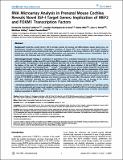Por favor, use este identificador para citar o enlazar a este item:
http://hdl.handle.net/10261/20472COMPARTIR / EXPORTAR:
 SHARE SHARE
 CORE
BASE CORE
BASE
|
|
| Visualizar otros formatos: MARC | Dublin Core | RDF | ORE | MODS | METS | DIDL | DATACITE | |

| Campo DC | Valor | Lengua/Idioma |
|---|---|---|
| dc.contributor.author | Sánchez-Calderón, Hortensia | - |
| dc.contributor.author | Rodriguez-de la Rosa, Lourdes | - |
| dc.contributor.author | Pichel, José G. | - |
| dc.contributor.author | Varela-Nieto, Isabel | - |
| dc.date.accessioned | 2010-01-29T13:29:01Z | - |
| dc.date.available | 2010-01-29T13:29:01Z | - |
| dc.date.issued | 2010-01-25 | - |
| dc.identifier.citation | PLoS ONE 5(1): e8699 (2010) | en_US |
| dc.identifier.issn | 1932-6203 | - |
| dc.identifier.uri | http://hdl.handle.net/10261/20472 | - |
| dc.description | 17 páginas, 8 figuras.-- et al. | - |
| dc.description.abstract | [Background]: Insulin-like growth factor-I (IGF-I) provides pivotal cell survival and differentiation signals during inner ear development throughout evolution. Homozygous mutations of human IGF1 cause syndromic sensorineural deafness, decreased intrauterine and postnatal growth rates, and mental retardation. In the mouse, deficits in IGF-I result in profound hearing loss associated with reduced survival, differentiation and maturation of auditory neurons. Nevertheless, little is known about the molecular basis of IGF-I activity in hearing and deafness. | en_US |
| dc.description.abstract | [Methodology/Principal Findings]: A combination of quantitative RT-PCR, subcellular fractionation and Western blotting, along with in situ hybridization studies show IGF-I and its high affinity receptor to be strongly expressed in the embryonic and postnatal mouse cochlea. The expression of both proteins decreases after birth and in the cochlea of E18.5 embryonic Igf1−/− null mice, the balance of the main IGF related signalling pathways is altered, with lower activation of Akt and ERK1/2 and stronger activation of p38 kinase. By comparing the Igf1−/− and Igf1+/+ transcriptomes in E18.5 mouse cochleae using RNA microchips and validating their results, we demonstrate the up-regulation of the FoxM1 transcription factor and the misexpression of the neural progenitor transcription factors Six6 and Mash1 associated with the loss of IGF-I. Parallel, in silico promoter analysis of the genes modulated in conjunction with the loss of IGF-I revealed the possible involvement of MEF2 in cochlear development. E18.5 Igf1+/+ mouse auditory ganglion neurons showed intense MEF2A and MEF2D nuclear staining and MEF2A was also evident in the organ of Corti. At P15, MEF2A and MEF2D expression were shown in neurons and sensory cells. In the absence of IGF-I, nuclear levels of MEF2 were diminished, indicating less transcriptional MEF2 activity. By contrast, there was an increase in the nuclear accumulation of FoxM1 and a corresponding decrease in the nuclear cyclin-dependent kinase inhibitor p27Kip1. | en_US |
| dc.description.abstract | [Conclusions/Significance]: We have defined the spatiotemporal expression of elements involved in IGF signalling during inner ear development and reveal novel regulatory mechanisms that are modulated by IGF-I in promoting sensory cell and neural survival and differentiation. These data will help us to understand the molecular bases of human sensorineural deafness associated to deficits in IGF-I. | en_US |
| dc.description.sponsorship | This work was partially supported by the Royal Society, DIGNA Biotech, Ministerio de Ciencia e Innovación (BFU2005-00084, SAF2008-00470) and the Fundación Mutua Madrileña. Hortensia Sanchez Calderon and Lourdes Rodriguez-de la Rosa hold contracts from Consejo Superior de Investigaciones Científicas-FSE I3 programme and Centro de Investigación Biomédica en Red de Enfermedades Raras (CIBERER), respectively. | en_US |
| dc.format.extent | 5773660 bytes | - |
| dc.format.mimetype | application/pdf | - |
| dc.language.iso | eng | en_US |
| dc.publisher | Public Library of Science | en_US |
| dc.relation.isversionof | Publisher's version | - |
| dc.rights | openAccess | en_US |
| dc.title | RNA microarray analysis in prenatal mouse mochlea reveals novel IGF-I target genes: Implication of MEF2 and FOXM1 transcription factors | en_US |
| dc.type | artículo | en_US |
| dc.identifier.doi | 10.1371/journal.pone.0008699 | - |
| dc.description.peerreviewed | Peer reviewed | en_US |
| dc.relation.publisherversion | http://dx.doi.org/10.1371/journal.pone.0008699 | en_US |
| dc.identifier.pmid | 20111592 | - |
| dc.type.coar | http://purl.org/coar/resource_type/c_6501 | es_ES |
| item.openairecristype | http://purl.org/coar/resource_type/c_18cf | - |
| item.fulltext | With Fulltext | - |
| item.cerifentitytype | Publications | - |
| item.openairetype | artículo | - |
| item.languageiso639-1 | en | - |
| item.grantfulltext | open | - |
| Aparece en las colecciones: | (IBMCC) Artículos (IIBM) Artículos | |
Ficheros en este ítem:
| Fichero | Descripción | Tamaño | Formato | |
|---|---|---|---|---|
| RNA microarray.pdf | 5,64 MB | Adobe PDF |  Visualizar/Abrir |
CORE Recommender
PubMed Central
Citations
49
checked on 07-abr-2024
SCOPUSTM
Citations
75
checked on 15-abr-2024
WEB OF SCIENCETM
Citations
71
checked on 22-feb-2024
Page view(s)
370
checked on 17-abr-2024
Download(s)
325
checked on 17-abr-2024
Google ScholarTM
Check
Altmetric
Altmetric
Artículos relacionados:
NOTA: Los ítems de Digital.CSIC están protegidos por copyright, con todos los derechos reservados, a menos que se indique lo contrario.
